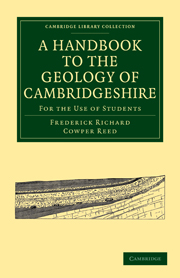THE PLEISTOCENE DEPOSITS
Published online by Cambridge University Press: 05 July 2011
Summary
There is a gap in the geological sequence over this area between the Zone of Micraster cor-testudinarium of the Upper Chalk and the Glacial Drift. The uppermost beds of the Upper Chalk have all been removed by denudation; and all the Tertiary beds are now absent, though some of them may possibly have once spread over the district. The late Pliocene beds which usher in the Glacial Period in the adjoining county of Norfolk and which are so well seen on the coast are completely wanting; and even the earlier glacial deposits are not represented, save possibly by some unimportant local patches of gravel at or near the base of the Boulder Clay.
The Pleistocene deposits may be conveniently treated under the following four heads:—
(1) The Glacial Drift including the Boulder Clay and the High Level Gravels.
(2) The River Gravels.
(3) The Fenland deposits.
(4) Recent Alluvium, warp and trail, etc.
THE GLACIAL DRIFT.
THE BOULDER CLAY.
Characters and thickness. In this area the Boulder Clay, which belongs to the Great Chalky Boulder Clay of East Anglia, consists mainly of a dark grey or bluish clay weathering to a drab or brownish colour to the depth of several feet. Locally its colour and contents vary according to the rocks on which it rests or which occur in the vicinity.
- Type
- Chapter
- Information
- A Handbook to the Geology of CambridgeshireFor the Use of Students, pp. 153 - 234Publisher: Cambridge University PressPrint publication year: 2009First published in: 1897



